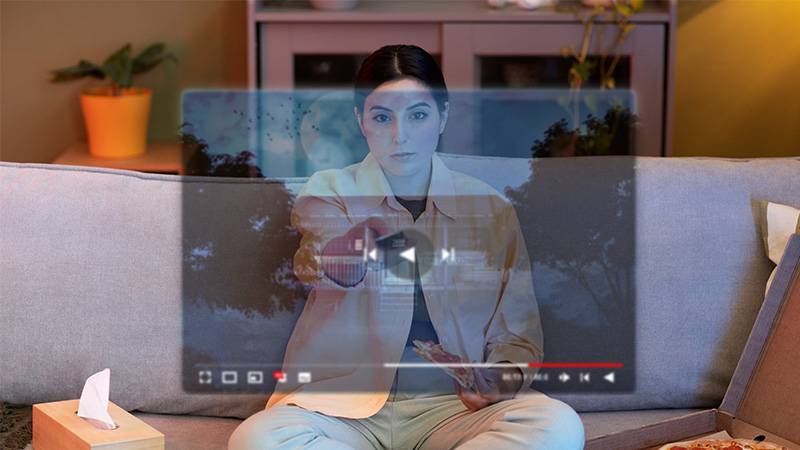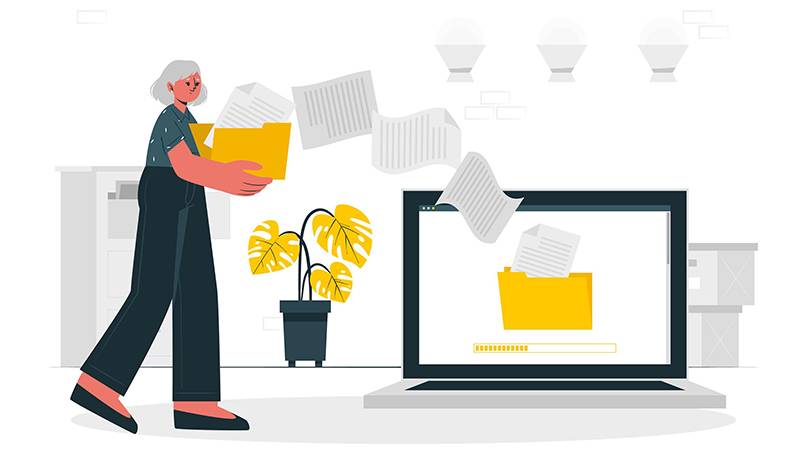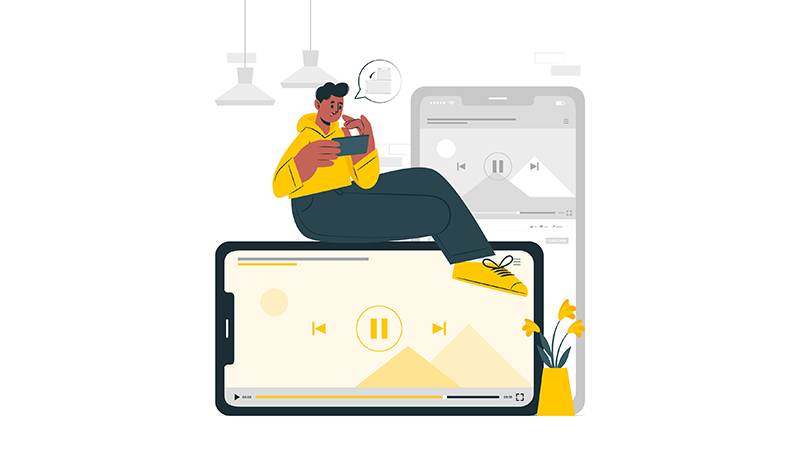In today's interconnected world, our online activities—from streaming videos to sending emails—have an invisible yet significant impact on the environment. This is known as our digital carbon footprint.
As someone deeply concerned about sustainability, I've been motivated to explore how we can navigate the digital space more responsibly.
The goal of this article is clear: to offer you actionable, research-based advice to reduce your digital carbon footprint. By making informed choices about our digital habits, we can collectively lessen our environmental impact and move towards a more sustainable future.

A digital carbon footprint refers to the total amount of carbon dioxide (CO2) and other greenhouse gases emitted due to the use of digital technologies. This includes everything from the energy used to power our devices to the immense data centers storing our emails, photos, and website data.
When we browse the web, stream a video, or even send an email, we're contributing to this footprint. These digital activities require electricity, much of which is generated from fossil fuels. The cumulative effect of the world's internet usage is substantial, making our digital behavior a significant concern for global sustainability efforts.
Understanding the relationship between our online habits and carbon emissions is the first step toward minimizing our impact. By recognizing the environmental cost of our digital consumption patterns, we can make more informed decisions that contribute to reducing our digital carbon footprint.
The Impact of Digital Consumption
The environmental impact of our digital consumption is more significant than many realize. Data centers, the backbone of our internet infrastructure, consume vast amounts of energy to store, process, and distribute the data we use every day. This energy use not only contributes to our digital carbon footprint but also demands extensive cooling systems to prevent overheating, further increasing their environmental impact.
Online streaming, a popular digital activity, is another major contributor. High-definition video streaming requires a large amount of data, which in turn requires significant energy to transmit and process. The convenience of streaming our favorite shows and movies comes with a hidden environmental cost, contributing to the overall carbon emissions of our digital habits.
The overall internet infrastructure, encompassing everything from network towers to the devices we use, all play a part in digital consumption's environmental impact. Every email sent, web page visited, and video streamed adds up, creating a demand for more energy and, as a result, more carbon emissions.
By understanding the environmental toll of data centers, online streaming, and our internet use, we can begin to explore ways to reduce our impact and move towards a more sustainable digital lifestyle.
Assessing Your Digital Habits
Digital Consumption Patterns
To start making a difference, it's essential to first understand your own digital consumption patterns. Reflect on your daily digital activities: How often do you stream videos or music? How much time do you spend browsing the internet? Consider the number of emails you send and receive, the frequency of your online shopping, and how regularly you use cloud storage services.
This reflection isn't about inducing guilt but about gaining awareness. By identifying your high-impact digital activities, you can pinpoint where changes can be most effective. It's the first step towards adopting more sustainable digital practices. Remember, even small adjustments in your digital habits can lead to significant reductions in your digital carbon footprint. Start by observing your digital behavior for a week, and you'll likely discover several opportunities to reduce your environmental impact.
Identifying High-Impact Areas

In our journey to minimize our digital carbon footprint, identifying the high-impact areas of our digital habits is crucial. Some common digital activities have significantly larger carbon footprints than others, making them key targets for reduction.
Emails, for example, may seem inconsequential, but the cumulative effect of sending, storing, and managing billions of emails daily contributes substantially to global carbon emissions.
Similarly, online streaming, especially in high definition, demands a high amount of data and energy, making it another high-impact area.
Cloud storage and online backups, while offering convenience and security, also require extensive data center resources, contributing to our digital footprint.
Social media browsing and online gaming, with their continuous data exchange and processing, round out the list of activities with notable environmental impacts.
Focusing on these areas can lead to more significant reductions in our digital carbon footprint, guiding us towards more sustainable digital practices.
Streamlining Digital Storage

Reducing your digital carbon footprint starts with streamlining your digital storage. The habit of hoarding unnecessary files not only clutters your devices but also demands more energy for storage, especially when using cloud services. Start by decluttering your digital files—delete old, unnecessary documents, photos, and emails. This simple step can significantly decrease the energy required to store your data.
When it comes to choosing storage options, prioritize energy-efficient solutions. Opt for cloud service providers that are committed to using renewable energy sources. These providers actively work to minimize their environmental impact, making your digital storage more sustainable.
Additionally, consider consolidating your files and using more efficient formats. For instance, compressing images and videos can drastically reduce their file size without compromising quality, thereby requiring less energy for storage and transmission.
Implementing these tips not only contributes to a more organized digital life but also plays a vital role in reducing the environmental impact of our digital storage habits. By making conscious choices about how and where we store our data, we can take a significant step towards minimizing our digital carbon footprint.
Optimizing Online Streaming Practices

Online streaming, while a significant source of entertainment, plays a major role in digital carbon emissions. However, you can enjoy your favorite shows and movies more sustainably by optimizing your streaming practices.
One effective strategy is to lower the video quality when high definition (HD) or ultra-high definition (UHD) isn't necessary. Watching videos in standard definition (SD) can drastically reduce the data required and, consequently, the energy consumed during streaming. This is particularly impactful for long binge-watching sessions or when background streaming as a noise filler.
Another tip is to download content for offline viewing instead of streaming it multiple times. This approach reduces repeated data transmission, cutting down on energy use. Ensure that downloads are done over a Wi-Fi connection, which is generally more energy-efficient than mobile data.
Consider using streaming services that have committed to reducing their carbon footprint. Some companies are actively working to improve their energy efficiency and power their data centers with renewable energy sources.
By adopting these practices, you can significantly lower the environmental impact of your streaming habits. Making small adjustments to how and what you stream can contribute to a larger positive effect on reducing digital carbon emissions.
Sustainable Web Browsing

Sustainable web browsing is an essential component of reducing your digital carbon footprint. Opting for energy-efficient web browsers is a straightforward yet effective strategy. Some browsers are designed to minimize energy consumption through optimized processing and reduced data usage. By choosing these browsers, you contribute to lower energy use each time you surf the web.
Additionally, consider the habit of unnecessary web searches. Each query we make consumes energy, from powering the servers that process our requests to delivering the results to our screens. To minimize this impact, think before you search. Bookmark frequently visited websites to access them directly and use browser extensions that help streamline your browsing, reducing the need to perform redundant searches.
Another valuable tip is to leverage ad blockers. Ads not only slow down your browsing experience but also consume more energy by loading additional data. Using an ad blocker can thus enhance browsing efficiency and reduce energy consumption.
By adopting these sustainable web browsing practices, you not only enhance your online experience but also significantly contribute to a reduction in digital carbon emissions. Small changes in our daily digital habits can lead to substantial environmental benefits over time.
Leveraging Technology for Sustainability
In our quest to reduce our digital carbon footprint, technology itself offers some powerful solutions. A variety of eco-friendly apps and tools have been developed to help us monitor and minimize our digital impact. These applications can track your digital habits, calculate your digital carbon footprint, and provide personalized recommendations for improvement.
For instance, energy consumption trackers can pinpoint which of your digital activities consume the most power, suggesting ways to adjust settings for efficiency. Carbon footprint calculators specifically designed for digital use can highlight areas where your online behavior could be more sustainable.
Additionally, some apps promote greener living by encouraging digital decluttering, offering tips on reducing email storage, and guiding towards more sustainable browsing habits. By leveraging these eco-friendly tools, we can make more informed decisions about our digital consumption, actively contributing to a lower digital carbon footprint and a healthier planet.
Supporting Green Tech Companies
Choosing services and products from companies that prioritize sustainability is a crucial step toward a greener digital footprint. When selecting tech companies, look for those committed to reducing environmental impact. This commitment can manifest in various ways, such as using renewable energy sources to power data centers, implementing energy-efficient practices, or participating in carbon offset programs.
Research companies' sustainability reports and public commitments to environmental responsibility. Support businesses that invest in green technologies and strive for carbon neutrality. By choosing these companies for your digital services and products, you not only benefit from their offerings but also contribute to a demand for sustainable practices in the tech industry.
Additionally, consider advocating for sustainability by providing feedback to companies on their environmental efforts. Encouraging businesses to adopt eco-friendly practices can have a ripple effect, pushing the tech industry towards a more sustainable future. Supporting green tech companies is a tangible way to align your digital consumption with your environmental values.
Conclusion
In conclusion, reducing our digital carbon footprint is essential for a sustainable future. By understanding the impact of our digital habits, decluttering digital storage, optimizing streaming practices, browsing sustainably, and supporting green tech companies, we can make a significant difference.
Individual actions, when multiplied by millions, can lead to a substantial global impact. Each step you take towards minimizing your digital footprint contributes to a healthier planet.
I encourage you to start making small changes to your digital habits today. Share this knowledge, inspire others, and together, let's strive for a more sustainable digital world.
Actionable Blog Posts
How to Reduce Your Digital Carbon Footprint
Written by : Eunice Rodriguez | Last Updated: March 11, 2024
Contents
Did you know that binge-watching your favorite series has a carbon footprint? Find out how to enjoy digital life more sustainably.
In today's interconnected world, our online activities—from streaming videos to sending emails—have an invisible yet significant impact on the environment. This is known as our digital carbon footprint.
As someone deeply concerned about sustainability, I've been motivated to explore how we can navigate the digital space more responsibly.
The goal of this article is clear: to offer you actionable, research-based advice to reduce your digital carbon footprint. By making informed choices about our digital habits, we can collectively lessen our environmental impact and move towards a more sustainable future.
What Is a Digital Carbon Footprint?
A digital carbon footprint refers to the total amount of carbon dioxide (CO2) and other greenhouse gases emitted due to the use of digital technologies. This includes everything from the energy used to power our devices to the immense data centers storing our emails, photos, and website data.
When we browse the web, stream a video, or even send an email, we're contributing to this footprint. These digital activities require electricity, much of which is generated from fossil fuels. The cumulative effect of the world's internet usage is substantial, making our digital behavior a significant concern for global sustainability efforts.
Understanding the relationship between our online habits and carbon emissions is the first step toward minimizing our impact. By recognizing the environmental cost of our digital consumption patterns, we can make more informed decisions that contribute to reducing our digital carbon footprint.
The Impact of Digital Consumption
The environmental impact of our digital consumption is more significant than many realize. Data centers, the backbone of our internet infrastructure, consume vast amounts of energy to store, process, and distribute the data we use every day. This energy use not only contributes to our digital carbon footprint but also demands extensive cooling systems to prevent overheating, further increasing their environmental impact.
Online streaming, a popular digital activity, is another major contributor. High-definition video streaming requires a large amount of data, which in turn requires significant energy to transmit and process. The convenience of streaming our favorite shows and movies comes with a hidden environmental cost, contributing to the overall carbon emissions of our digital habits.
The overall internet infrastructure, encompassing everything from network towers to the devices we use, all play a part in digital consumption's environmental impact. Every email sent, web page visited, and video streamed adds up, creating a demand for more energy and, as a result, more carbon emissions.
By understanding the environmental toll of data centers, online streaming, and our internet use, we can begin to explore ways to reduce our impact and move towards a more sustainable digital lifestyle.
Assessing Your Digital Habits
Digital Consumption Patterns
To start making a difference, it's essential to first understand your own digital consumption patterns. Reflect on your daily digital activities: How often do you stream videos or music? How much time do you spend browsing the internet? Consider the number of emails you send and receive, the frequency of your online shopping, and how regularly you use cloud storage services.
This reflection isn't about inducing guilt but about gaining awareness. By identifying your high-impact digital activities, you can pinpoint where changes can be most effective. It's the first step towards adopting more sustainable digital practices. Remember, even small adjustments in your digital habits can lead to significant reductions in your digital carbon footprint. Start by observing your digital behavior for a week, and you'll likely discover several opportunities to reduce your environmental impact.
Identifying High-Impact Areas
In our journey to minimize our digital carbon footprint, identifying the high-impact areas of our digital habits is crucial. Some common digital activities have significantly larger carbon footprints than others, making them key targets for reduction.
Emails, for example, may seem inconsequential, but the cumulative effect of sending, storing, and managing billions of emails daily contributes substantially to global carbon emissions.
Similarly, online streaming, especially in high definition, demands a high amount of data and energy, making it another high-impact area.
Cloud storage and online backups, while offering convenience and security, also require extensive data center resources, contributing to our digital footprint.
Social media browsing and online gaming, with their continuous data exchange and processing, round out the list of activities with notable environmental impacts.
Focusing on these areas can lead to more significant reductions in our digital carbon footprint, guiding us towards more sustainable digital practices.
Practical Steps to Reduce Your Digital Carbon Footprint
Streamlining Digital Storage
Reducing your digital carbon footprint starts with streamlining your digital storage. The habit of hoarding unnecessary files not only clutters your devices but also demands more energy for storage, especially when using cloud services. Start by decluttering your digital files—delete old, unnecessary documents, photos, and emails. This simple step can significantly decrease the energy required to store your data.
When it comes to choosing storage options, prioritize energy-efficient solutions. Opt for cloud service providers that are committed to using renewable energy sources. These providers actively work to minimize their environmental impact, making your digital storage more sustainable.
Additionally, consider consolidating your files and using more efficient formats. For instance, compressing images and videos can drastically reduce their file size without compromising quality, thereby requiring less energy for storage and transmission.
Implementing these tips not only contributes to a more organized digital life but also plays a vital role in reducing the environmental impact of our digital storage habits. By making conscious choices about how and where we store our data, we can take a significant step towards minimizing our digital carbon footprint.
Optimizing Online Streaming Practices
Online streaming, while a significant source of entertainment, plays a major role in digital carbon emissions. However, you can enjoy your favorite shows and movies more sustainably by optimizing your streaming practices.
One effective strategy is to lower the video quality when high definition (HD) or ultra-high definition (UHD) isn't necessary. Watching videos in standard definition (SD) can drastically reduce the data required and, consequently, the energy consumed during streaming. This is particularly impactful for long binge-watching sessions or when background streaming as a noise filler.
Another tip is to download content for offline viewing instead of streaming it multiple times. This approach reduces repeated data transmission, cutting down on energy use. Ensure that downloads are done over a Wi-Fi connection, which is generally more energy-efficient than mobile data.
Consider using streaming services that have committed to reducing their carbon footprint. Some companies are actively working to improve their energy efficiency and power their data centers with renewable energy sources.
By adopting these practices, you can significantly lower the environmental impact of your streaming habits. Making small adjustments to how and what you stream can contribute to a larger positive effect on reducing digital carbon emissions.
Sustainable Web Browsing
Sustainable web browsing is an essential component of reducing your digital carbon footprint. Opting for energy-efficient web browsers is a straightforward yet effective strategy. Some browsers are designed to minimize energy consumption through optimized processing and reduced data usage. By choosing these browsers, you contribute to lower energy use each time you surf the web.
Additionally, consider the habit of unnecessary web searches. Each query we make consumes energy, from powering the servers that process our requests to delivering the results to our screens. To minimize this impact, think before you search. Bookmark frequently visited websites to access them directly and use browser extensions that help streamline your browsing, reducing the need to perform redundant searches.
Another valuable tip is to leverage ad blockers. Ads not only slow down your browsing experience but also consume more energy by loading additional data. Using an ad blocker can thus enhance browsing efficiency and reduce energy consumption.
By adopting these sustainable web browsing practices, you not only enhance your online experience but also significantly contribute to a reduction in digital carbon emissions. Small changes in our daily digital habits can lead to substantial environmental benefits over time.
Leveraging Technology for Sustainability
Eco-Friendly Apps and Tools
In our quest to reduce our digital carbon footprint, technology itself offers some powerful solutions. A variety of eco-friendly apps and tools have been developed to help us monitor and minimize our digital impact. These applications can track your digital habits, calculate your digital carbon footprint, and provide personalized recommendations for improvement.
For instance, energy consumption trackers can pinpoint which of your digital activities consume the most power, suggesting ways to adjust settings for efficiency. Carbon footprint calculators specifically designed for digital use can highlight areas where your online behavior could be more sustainable.
Additionally, some apps promote greener living by encouraging digital decluttering, offering tips on reducing email storage, and guiding towards more sustainable browsing habits. By leveraging these eco-friendly tools, we can make more informed decisions about our digital consumption, actively contributing to a lower digital carbon footprint and a healthier planet.
Supporting Green Tech Companies
Choosing services and products from companies that prioritize sustainability is a crucial step toward a greener digital footprint. When selecting tech companies, look for those committed to reducing environmental impact. This commitment can manifest in various ways, such as using renewable energy sources to power data centers, implementing energy-efficient practices, or participating in carbon offset programs.
Research companies' sustainability reports and public commitments to environmental responsibility. Support businesses that invest in green technologies and strive for carbon neutrality. By choosing these companies for your digital services and products, you not only benefit from their offerings but also contribute to a demand for sustainable practices in the tech industry.
Additionally, consider advocating for sustainability by providing feedback to companies on their environmental efforts. Encouraging businesses to adopt eco-friendly practices can have a ripple effect, pushing the tech industry towards a more sustainable future. Supporting green tech companies is a tangible way to align your digital consumption with your environmental values.
Read More:
What is Sustainable Web Design and How to Implement It
Conclusion
In conclusion, reducing our digital carbon footprint is essential for a sustainable future. By understanding the impact of our digital habits, decluttering digital storage, optimizing streaming practices, browsing sustainably, and supporting green tech companies, we can make a significant difference.
Individual actions, when multiplied by millions, can lead to a substantial global impact. Each step you take towards minimizing your digital footprint contributes to a healthier planet.
I encourage you to start making small changes to your digital habits today. Share this knowledge, inspire others, and together, let's strive for a more sustainable digital world.
Eunice Rodriguez
Eunice is a sustainability writer whose passion is sharing accessible eco-friendly practices with GreenCitizen's global readership. She enjoys birdwatching during her downtime, often deriving inspiration from nature's resilience. An enthusiastic cyclist, she is also an ardent advocate of eco-friendly transport.
Quick Links
Green Living Guides
Green Jobs
Inspiring Green News
Green Directory
Green Store
Electronics Recycling
Category: Actionable Blog Posts, Sustainable Living